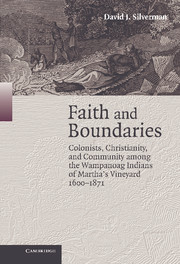 Faith and Boundaries
Faith and Boundaries Published online by Cambridge University Press: 17 December 2010
An islander's life is ever attuned to the weather, and that was particularly true in colonial New England. Throughout any given day, salt-crusted fishermen and sun-bleached farmers scanned the horizon for signs of the next nor'easter, a torrent of wind and water that devoured boats and flattened crops during the warm months, and dumped ungodly amounts of snow in just a few hours in winter. One can be certain that Vineyarders were watching the sky during the last week of June 1675, and, if it was clear, Indians atop Menemsha's hills or Aquinnah's shoreline cliffs might have seen smoke billowing from the smoldering mainland towns of Swansea, Rehoboth, and Taunton. After nearly annual rumors of an Indian conspiracy and, more recently, heightened tensions between mainland Wampanoags and Plymouth, one question would have immediately flashed through their minds: “Had Philip's men finally struck against the English?” To find out, messengers would have raced to alert all the Vineyard sachems and the Mayhews in Edgartown, followed by a scramble for reliable news. While awaiting confirmation, Indians and Englishmen who commonly worked and traded together would begin to eye one another suspiciously. The future was very uncertain in the summer of 1675.
Still, there was reason to believe that this was just another in a string of false alarms, that the smoke rose from a mere house fire or forest blaze that had spread out of control.
To save this book to your Kindle, first ensure [email protected] is added to your Approved Personal Document E-mail List under your Personal Document Settings on the Manage Your Content and Devices page of your Amazon account. Then enter the ‘name’ part of your Kindle email address below. Find out more about saving to your Kindle.
Note you can select to save to either the @free.kindle.com or @kindle.com variations. ‘@free.kindle.com’ emails are free but can only be saved to your device when it is connected to wi-fi. ‘@kindle.com’ emails can be delivered even when you are not connected to wi-fi, but note that service fees apply.
Find out more about the Kindle Personal Document Service.
To save content items to your account, please confirm that you agree to abide by our usage policies. If this is the first time you use this feature, you will be asked to authorise Cambridge Core to connect with your account. Find out more about saving content to Dropbox.
To save content items to your account, please confirm that you agree to abide by our usage policies. If this is the first time you use this feature, you will be asked to authorise Cambridge Core to connect with your account. Find out more about saving content to Google Drive.